The perfect holiday in Myanmar - our expert's ultimate itinerary
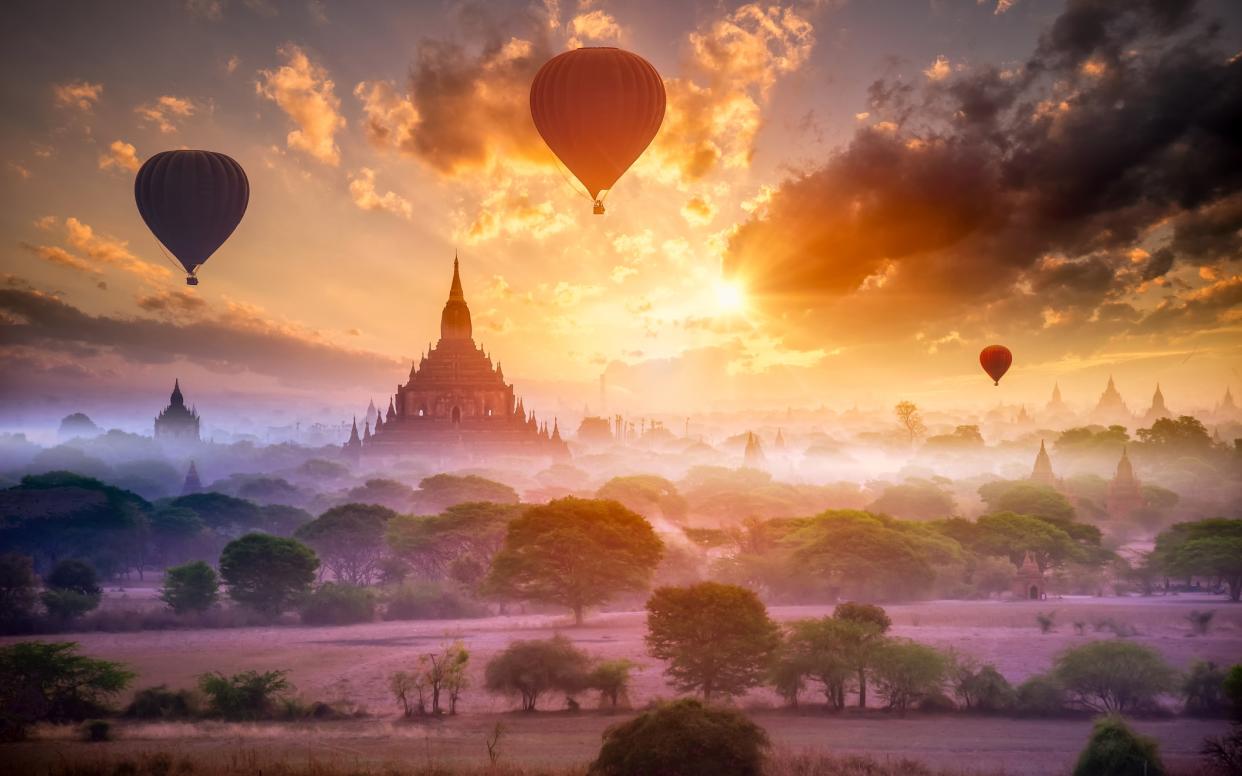
Burma - also known as Myanmar - is a place of engaging small delights as well as wondrous sights that include the great 12th-century temple city of Bagan (now a UNESCO World Heritage site); the leg-rowing fishermen and floating gardens of Inle Lake, and the majestic Irrawaddy that flows unfettered from the Himalayas into the Bay of Bengal.
I have been visiting the country for over 30 years and this tour includes some of my favourite places and will take you beyond the usual tourist trail. Rather than rushing at the big-name sights and risking chronic temple fatigue, it includes time spent in traditional teak villages, convivial teahouses and small-town markets getting to know some of the most endearing people you will meet anywhere in the world.
I have also included a short cruise on the Irrawaddy aboard a classic riverboat. In a land with few roads wider than an English country lane, the river is a major transport highway. Yet it retains an extraordinary timeless quality. The kings of Bagan would recognise riverbank life today: the bullock carts and ox-ploughs, the tiered pagodas and rambling teak monasteries, and the villages of thatched homes raised on stilts, each with a dugout canoe slung beneath for when the summer monsoon turns paths into waterways.
The country has had a long, complicated history, wtih an oppressive military junta in place from 1962 to 2011. The election of Aung San Suu Kyi in the free elections of 2015 sparked hope for a more progressive future, but the recent treatment of Muslim Rohingyas in the country has seriously damaged the goverment's reputation. It is frustrating for the ever-hopeful Burmese who are keen to see more progress in human rights and development to help the country compete with its south-east Asian neighbours.
Given the parlous state of the roads and the ageing rail network, it is best to fly between Mandalay, Heho (for Inle Lake), Bagan and Yangon and organise sightseeing locally. It costs around £40 to hire a car and driver for a day, and a further £40 for a knowledgeable guide.
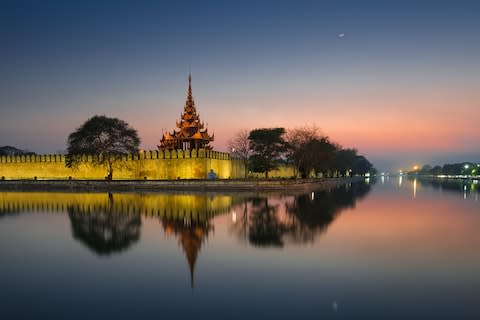
Tip drivers around £5 a day and guides £10. Hotels can organise day-tours at short notice though I always like to meet drivers in advance to make sure their English is up to scratch.
I have chosen to start the tour in Mandalay which has good flight connections with Bangkok and avoids the need to visit traffic-choked Yangon more than once. In a country were so much is still made by hand, I have included visits to the workshops of bronze casters and marble carvers, village potters, and handloom weavers who create intricate ikat silks.
Most tours do not spend enough time in and around Inle Lake which sits in a beautiful, almost Tuscan landscape, home to the Inthar and Pa’O peoples whom you will visit in their villages rather than simply snapping with a camera - as most tourists do - when they come to trade at one of the lake’s markets.
The tour finishes in Yangon, the old British capital, which has a vibrant downtown filled with colonial-era buildings and fascinating markets, watched over by the great golden stupa of the Shwedagon Pagoda where people from all walks of life come to pray here. Watching the worshippers in action - and engaging them in conversation - gives a real insight into a country where Buddhism is still a way of life.
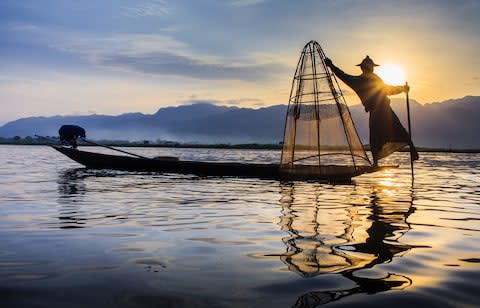
The itinerary
Day 1
Fly from London to Mandalay via Bangkok on Thai Airways departing 11.50 from Heathrow. Although the Bangkok-Mandalay sector is operated by its subsidiary Thai Smile you should be able to check your bags through.
The road to Mandalay and beyond
Day 2
Arrive in Mandalay at 11.15. Fixed-price taxi costs K15,000 (£9) to the city; vouchers sold in arrivals hall. The boutique Hotel by the Red Canal is well situated with friendly efficient service and has a pool, small spa, and an excellent Indian restaurant. In the afternoon stretch your legs by walking north on 63rd Street to the ornatedly carved Shwenandaw Monastery, the only remaining building from Mandalay’s royal palace fire bombed by the British in World War ll (the shoddy reconstruction is not worth visiting). Afterwards take the south staircase to the top of Mandalay Hill for sunset (there’s a lift for the weary) where teenage novice monks come to practice their English with visitors.

Day 3
Set off 8.30am by car to explore Inwa before the tour groups pile inat 10.15. The capital of Burma for five centuries, it is now a sleepy village scattered with ruined palaces and temples reached by horsecart. The highlight is the glorious teak Bagaya Kyuang monastery whose abbot still teaches in the main hall. After a walk on the photogenic U Bein bridge in Amarapura, head for the Mahamuni Temple now the morning crowds have gone.
The country’s most important shrine, pilgrims buy gold leaf to press on the precious image which they believe is an exact likeness of the Buddha. Don’t leave without visiting the bronze-casting workshops in nearby Tampawady where skilled craftsmen create larger-than-life images ofthe Buddha and General Aung San using the lost-wax process. For an authentic Burmese supper in a pleasant open-sided pavilion take a taxi to A Little Bit of Mandalay on 53rdstreet.
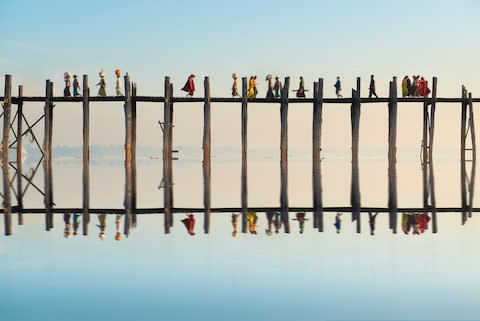
Slowly down the Irrawaddy
Day 4
Scottish-owned Pandaw pioneered cruises on the Irrawaddy, basing the design of its river boats on the original Clyde-built paddle-steamers. Cabins have teak and brass detailing and the wrap-around observation deck is a convivial gathering place.
Choose the two-night cruise from Mandalay to Bagan (from £550 per person including meals). There’s plenty to capture with a camera as you drift past fishingcanoes, vast bamboo rafts and cargo barges, villages shaded by spreading banyans, and hills glinting with golden spires. The light at sunset is magical.
Day 5
The riverboat stops at Yandabo where village potters make terracotta water jars sold all over the country. In the afternoon, there’s another excursion to the country town of Pakokku which has a lively market (jaggery sweets and shopping baskets woven from coloured plastic are top buys) and a cheroot-making industry.
Bagan: the thousand temple plain
Day 6
Disembark after breakast at Nyaung-U, a few miles from Old Bagan. The Hotel @Tharabar Gate is my favourite place to stay (central, spacious villa rooms set in lush garden with pool, hands-on Dutch manager). It can arrange cycle or horse-cart hire to visit the temples. Start at the Ananda Temple which has four massive standing images. The bookstall at the west entrance sells Ma Thanegi’s helpful guide to the monuments, Bagan Mystique.
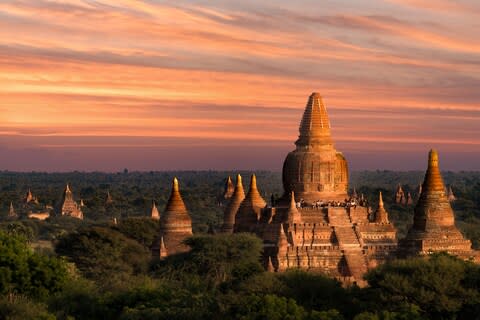
Don’t miss the Myinkaba Gubyauk Gyi which has superb murals restored by UNESCO. Sunset-watching is an institition in Bagan as the brick pagodas turn abrilliant orange. Head for the roof terrace of quieter Oak Kyaung Gyinorth of Anawrahta Road beyond Ywa Haung Gyi. The steps are steep, dark and narrow so bring a torch.
Day 7
If your budget allows, splash out on a dawn flight (£325) to appreciate the monumental scale of royal patronage in this powerful 12th-century kingdom. Later, escape the tourist horde by touring the eastern temples around Minnanthu village which have some entertaining murals of everyday life. When you are templed-out watch the lacquer ware artists in Myinkaba village. Maung Aung Myin speaks fluent English and his workshop makes the finest quality pieces in Bagan; call 0095 61 65047 for directions. Dine at The Moon, a superb vegetarian restaurant in an open-air yard down a track across from the hotel.
Among the leg-rowing fishermen of Inle Lake
Day 8
Take a morning flight to Heho. Pindaya Farmhouse is a new five-room property set in rolling hills reminscent of Tuscany. It’s a perfect escape from the beaten tourist trail. A half-hour walk across mustard fields brings you to Pindaya, a sleepy market town set around a holy lake where tribal women come to trade.
Day 9
Set off early for the Pindaya Caves to avoid the tour groups. These large limestone caverns contain over 8,000 Buddha images framed bystalactites, some dating back 200 years. It’s a lovely walk back down to the lakeside Green Tea Restaurant for lunch. Transfer to Nyuangshwe at the head of Inle Lake for a longtailed boat transfer to Inle Heritage at the entrance to Inpawkhon village. A stylish small eco-resort built on stilts over the lake, it has the best food on the lake and breeds Burmese cats (they have their own compound) which you can visit and play with.
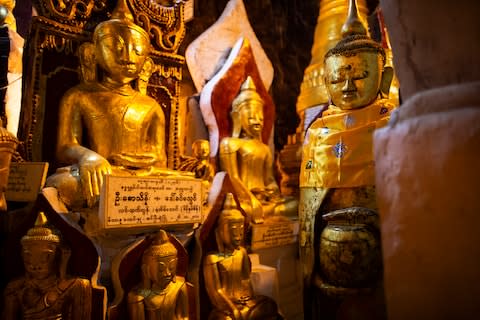
Day 10
Rent a longtail boat for the day for around £30. Start by exploring Inpawkhon on foot; use its boardwalks and bridges to meet the locals and see how they live on water. The village is famous for lotus and silk weaving; view the whole process in Ko Than Hlaing’s creaky teak workshops. Later, head north to Ywama known for its silversmiths (Sein Thamadi’s workshop is recommended) and drift through the Kay La floating vegetable gardens to the Nga Phe Kyaung monastery which has an exceptional collection of bamboo and lacquer Buddha images. Lovers of the decorative arts should finish the day at Indein reached along a tree-shaded canal. The hilltop temple has been blinged up horribly but at its base - and slowly being destroyed by strangler figs - are some of the best stucco bas-reliefs on the lake, a menagerie of mythical beasts and comely spirits.

Day 11
Instead of poking a camera at Pa’O women at one of the lake’s five-day markets, meet them in person with an English-speaking Pa’O guide. Community Involved Tourism offers a fascinating glimpse into their farming communities on a gentle walk from Nampan and includes a delicious vegetarian lunch cooked in a Pa’O home.
Yangon: the capital of British Burma
Day 12
Fly from Heho to Yangon, the rundown leafy British colonial capital. Check into The Loft, a French-owned boutique hotel (33 Yaw Min Gyi Street) which is well located for exploring downtown on foot. The Yangon Heritage Trust advocates for the protection of the colonial city and runs culturalwalks. Join its 3pm ‘East Downtown and the Secretariat’ excursion to hear the stories behind the buildings. Afterwards enjoy a cocktail at the century-old Strand Hotel before dining around the corner at Monsoon (85 Thein Phyu Road; 0095 1295224). Next door, Pomelo sells good-quality fair trade handicrafts.
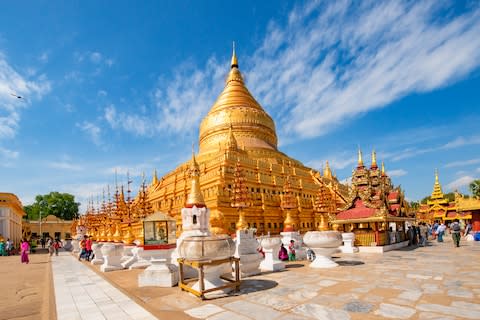
Day 13
It really is worth setting your alarm to visit the Shwedagon Pagoda at dawn; the locals retreat as camera-totting tour groups mass on the platform later. Set off from The Loft no later than 6.15am for thebrisk 30-minute walk up to the southern entrance. The £5 entry fee includes a useful guide-map to the various monuments. After breakfast, walk around the corner to Bogyoke Aung San market (also known as Scott Market and closed Monday's) where monied locals come to buy dress fabric, velvet slippers, gold and silver.
In the late afternoon, head for the river and the grid of streets built by Indian and Chinese traders, filled with family enterprises, temples and traditional shop-houses. Cross Strand Road at 17th Street to watch the sun set from a pontoon on the river as commuters travel home in jaunty wooden boats. A new, more hygenic, night food market has been set up along Strand Road selling everything from fried grasshoppers to mangrove crabs.
Day 14
Take the 09.50 Thai Airways flight from Yangon via Bangkok to London, arriving at 19.35.
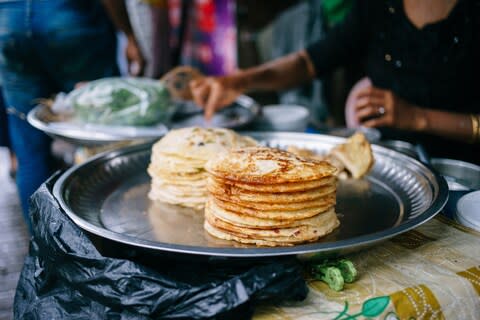
When to go
The best time to visit is from November to March when the weather is balmy, with daytime highs around 28C and night-time lows averaging 15C. The highlands and hill stations are cooler, so bring layers or visit closer to the summer months. Bagan and Mandalay are very hot and dry, so a visit in the wet season will help you avoid the winter crowds, without experiencing too much rain.
How to get there
Gill Charlton’s itinerary offers a well-paced tour, aimed at independent travellers. Alternatively, an 18-day tailor-made Classic Burma holiday with Audley Travel (01993 838000; audleytravel.com) starts from £5,890 per person, including flights and most meals.
Other tour companies offering Myanmar itineraries include Steppes Travel (01285 880980; steppestravel.co.uk) and Wild Frontiers (020 7736 3968; wildfrontierstravel.com).
While the majority of Myanmar is safe to travel to, the Home Office does advice against all but essential travel to certain areas (gov.uk)

Inspiration for your inbox
Sign up to Telegraph Travel's new weekly newsletter for the latest features, advice, competitions, exclusive deals and comment.


